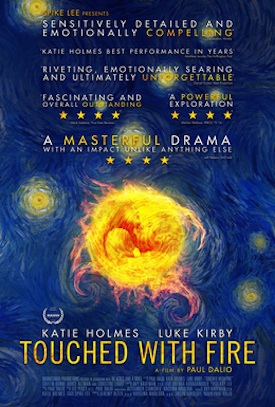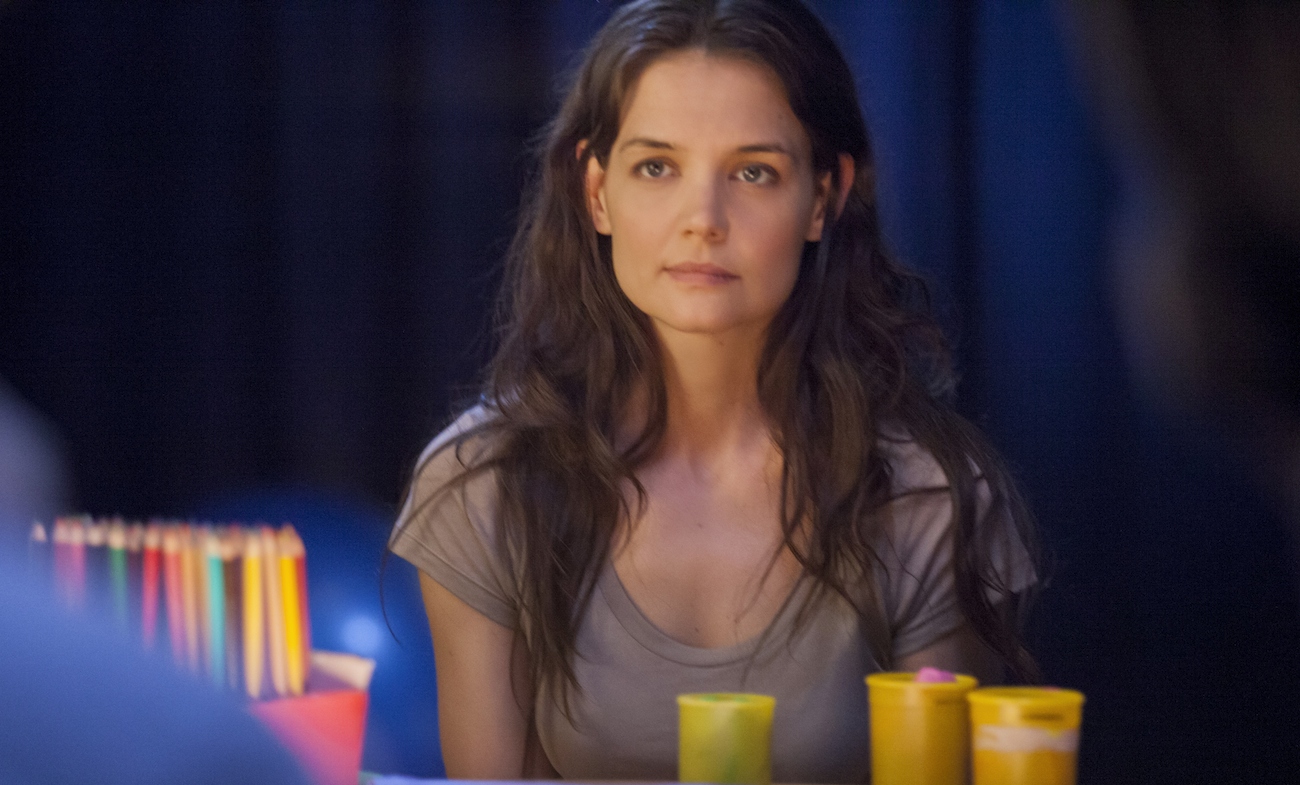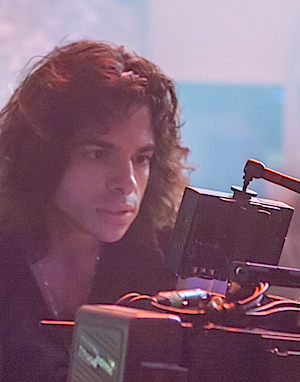 Touched with Fire stars Katie Holmes and Luke Kirby as two people with bipolar disorder. They are both poets whose art is fueled by their emotional extremes. When they meet in a treatment facility, their chemistry is instant and intense, driving each other’s mania to new heights. They pursue their shared passion which takes them from fantastical highs to tormented lows until they ultimately must choose between sanity and love. Inspired by his own struggles overcoming bipolar disorder, Paul Dalio wrote, directed, and scored this film, which was executive produced by Spike Lee and also includes excellent performances by Christine Lahti, Griffin Dunne, and Bruce Altman. I spoke to Paul Dalio about his emotional feature film debut.
Touched with Fire stars Katie Holmes and Luke Kirby as two people with bipolar disorder. They are both poets whose art is fueled by their emotional extremes. When they meet in a treatment facility, their chemistry is instant and intense, driving each other’s mania to new heights. They pursue their shared passion which takes them from fantastical highs to tormented lows until they ultimately must choose between sanity and love. Inspired by his own struggles overcoming bipolar disorder, Paul Dalio wrote, directed, and scored this film, which was executive produced by Spike Lee and also includes excellent performances by Christine Lahti, Griffin Dunne, and Bruce Altman. I spoke to Paul Dalio about his emotional feature film debut.
Danny Miller: There are a lot of films that touch on mental illness with varying degrees of success. I thought this film was so effective in how it treated bipolar disorder. Did you worry how the film would be perceived?
Paul Dalio: I know that a lot of people suffer from this condition and that everyone has a different experience. What I definitely didn’t want is for anyone to think I was romanticizing it. We’ve had many screenings for mental health organizations and universities and hospitals and I’ve been so pleased at how positive the reception has been, including by people who have bipolar disorder as well as their family members. I was really excited by that, and even a little surprised — I just didn’t know how it would be received.
What I really appreciate about the film is how there are no villains in this story — even though there are obviously people who are scared and don’t know what’s going on. I thought Christine Lahti was so moving in how she conveyed that look of love and terror in her eyes as she tries to figure out how to help her daughter.
The last thing I wanted to do with this film was put up any walls — my main goal was to break down those barriers. I wanted to show that the family members and doctors can be well-intentioned even while they sometimes have no clue how to help. It frustrates me in films when these groups get demonized.
You definitely touch on the supercharged creativity that is part of this illness during manic episodes. Did you have any fears that some people could see this as some kind of message to not take their medication?
Yeah, I definitely thought about that even though that’s clearly not the message of the film. But I knew that if I denied that creativity, people would feel it was a lie. I wanted to be as truthful as I could about it and show with these two characters how their creativity was brought out but also all the pain and negative consequences that came with the mania. I didn’t want people to feel that I was lying about what goes on during a manic episode but I definitely wanted to show the other side of that as well. You know, a lot of people with bipolar have great difficulty with being told their condition isn’t a gift when there are times that they really feel that it is. Sometimes they have to go through hell before they get the message. It was important to me that these characters had to go really far to the point where I’d hope anyone in the audience who is bipolar would say, “I don’t want to go down that road.”
And, of course, you show how it’s not about the two choices of being completely manic or deadened to all emotions — but that it takes time to find just the right medications for each person.
Yes, I think that is so important. When I was struggling with my medication, I didn’t believe the people who told me it was going to be better. How could they know what I was feeling? Many bipolar people do think it’s an either/or. That’s what I felt for a long time until I discovered through my own experience that with the right medication I could feel a much deeper and richer creativity. The first person I really listened to was Kay Jamison who wrote the book called Touched with Fire. I believed her because she had it herself and had experienced all of that. That’s why it was so meaningful for me to have her in the film so she could tell that to the world in her own words. That scene wasn’t scripted at all but she phrased it so perfectly. I think that if patients knew all they could feel and how much creativity they could have, they would definitely take the time to find the right medication.
Katie Holmes and Luke Kirby give such great performances in this film. You can be a really good actor but still have a hard time conveying mental illness on film. Were you ever worried about them being able to pull it off?
Because of how intensely both of them were drawn to these roles, I knew there was something in them that would enable them to play these characters. We had a lot of discussions about how they felt about these people and how they could use their own experience in their performances. We also worked on very vivid backstories for the characters — not just random facts about their lives but very emotion-charged things that happened to them that informed who they were in the present. I even wrote this scene between Luke and his mother (who is not in the film at all) where she talks to him about the “bipolar magic.” That allowed Luke to understand why he resented his father so much. I also talked a lot with Katie a lot about her relationship throughout her life with her mother. But both of these actors have an extraordinary range of emotions and fantastic imaginations. They spent of time getting into the skins of these characters beforehand.
I loved the way you used Van Gogh’s “The Starry Night” throughout the film.
I had a lot of poetry from bipolar poets all over the set describing mania along with paintings from bipolar artists and songs from bipolar composers. And then I put a lot of trust into Katie and Luke. As someone who is bipolar, I felt that they were showing exactly what it is like, they are such extraordinary actors.



